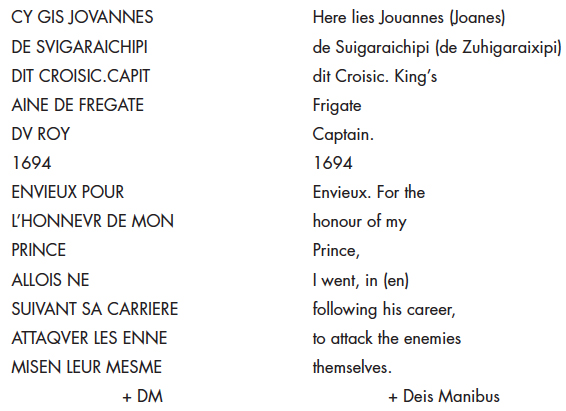Papers on the Basques in Newfoundland and Labrador in the Seventeenth Century
A Permanent Place in Newfoundland:
Seventeenth-Century Basque Tombstones in Placentia
Introduction
in the place where those who die here are buried.”
— Domingo de Luza, 1563
1 From the earliest times when they began hunting whales, the Basques developed a series of technologies and tools that were entirely unknown elsewhere in Europe. In the Middle Ages, this activity took them to hunting grounds as far west as the Galician coast and involved increasing numbers of Basques from both sides of the Pyrenees. In the sixteenth century, crews from Bizkaia, Gipuzkoa, and Lapurdi built an intensive transatlantic whale fishery in the land called Terranova in Spanish official records and Ternua in Basque literature. At the same time, Basques went to Newfoundland to fish for cod, or bacallao as the name appears on many early maps, and they also returned to Europe with less studied products such as animal skins and whale spermaceti. The resources of this “New Land” had less interest for the emerging European states than for the distinctive maritime peoples who inhabited the Atlantic facade of Europe.
2 Many of these intrepid fishermen returned regularly to the same ports. A certain Captain Zabaleta of Donibane Lohitzun (Saint-Jean-de-Luz) had spent 42 summers at “Port Savalet” in Nova Scotia, where Samuel de Champlain met him in 1609 and named the place in his honour (Egaña Goya, 2010: 384). Others sailors were less fortunate and lost their lives far from home. The memory of these sailors is permanently preserved by a group of Basque tombstones that are found in Placentia, Newfoundland.
3 The Placentia tombstones are part of a wider body of evidence regarding the spirituality of Basque fishermen in the New World. One of the classic writers of seventeenth-century literature in Euskera (the Basque language) is Joannes Detcheberri from Ziburu (Ciboure in French), who in 1669 wrote prayers for sailors. Some popular anonymous verses compiled in 1798 include “Ternua,” the Basque name for Newfoundland (Urkizu, 1987; Arcocha, 1998). Between 1563 and 1632, we have the last will and testament of sailors who died at Red Bay, West St. Modest, Carrol Cove, New Ferolle, and Placentia (Barkham, 1974: 76; Barkham, 1988: 116–17, 184–86 1 ). We know that chaplains accompanied crews to Terranova as early as 1549 (Proulx, 2007: 86 n. 300; Barkham, 1974: 78–79 n. 9). Franciscan brothers ran sailors’ missions in several Basque ports and, in 1612, they founded the one in Doni-bane Lohitzun (Saint-Jean-de-Luz) (Intxausti, 1998: 174). According to Landry (2013: 32–34) 2 they accompanied fishermen to areas under French rule as far west as Chaleur Bay. A Basque cemetery at Red Bay, Labrador, contains the archaeological remains of more than 130 persons, placed in 63 graves (White, 2015). It has been suggested that an adjacent temporary structure may have been used as a chapel (Delmas, 2017). Although the original layout of the Placentia cemetery is unknown, it eventually had a chapel and became a permanent sacred place.
4 We have analyzed the inscriptions on the seventeenth-century tombstones at Placentia from a linguistic perspective, to shed new light on their meaning and to enlarge the known repertory of Basque grave markers in Newfoundland. The stones are located in the town of Placentia, on the south coast of Newfoundland, which was the principal Basque fishing port in this region for at least 200 years, from before 1530 to at least 1760. Three of the monuments are kept in the O’Reilly House Museum in Placentia, and half of a fourth tombstone is held at the Castle Hill National Historic Site, also in Placentia. The other half, as well as the fifth stone, disappeared since they were described in the nineteenth century. All were originally located in the cemetery that surrounds St. Luke’s Anglican Church, built on the location of the Franciscan chapel, and constituted a unique and distinctive landmark in the town’s historic area.
5 The earliest reference to a Basque burial ground in Placentia dates to 1563, in the last will and testament of Domingo de Luza (Luça), who requested “that my body be buried in this port of Placentia, in the place where those who die here are buried.” 3 As well, a sailor from Pasai Donibane named Gracian de Caselis received his last sacrament in 1585 at Placentia, implying the presence of a priest (Barkham, 1974: 76). Church records, as shown by Michael Francis Howley, picked up the history of this sacred place in the seventeenth century:
6 Although the gravestones have been known to Basque scholars since the beginning of the twentieth century, from a 1908 article by Howley that appeared in the Revista Internacional de Estudios Vascos, the interpretation of their inscriptions has remained problematic, in part because the stones are much deteriorated by climatic exposure, as is typical in outdoor cemeteries, but also because only the original, imperfect drawings — and no photographs — have been available for study. During our comparison of the original drawings and the photographs of the entire assemblage, we identified at least one stone that has not previously been analyzed in any manner.
7 The graves themselves represent a permanent bond between two worlds, the Basque Country and the distant land where these fishermen worked and died, but whose memory remains graven in stone. As in the Basque Country, these markers unite the past and the present, and they also bear witness to a specific language and its funerary culture, preserving various historical Christian given names, surnames, and titles from as early as the fourteenth century. At a time when the living memory of the Basque transatlantic fisheries is fading, these stones and the names they bear are a physical link to those distant times and places.
8 Four of the stones were sketched and analyzed in a paper published by Michael Francis Howley in 1902. Howley (1843–1914) was the first Catholic Archbishop of Newfoundland. Highly cultivated, he wrote the first ecclesiastical history of Newfoundland. His research on the tombstones shows that he knew French and Gaelic, and the sight of these tombstones with their inscriptions in a language he did not know sparked his interest. He made drawings of the stones when he first saw them in 1872 and discussed them in his Ecclesiastical History of Newfoundland (Howley, 1888: 144–45). At that time, he thought the inscriptions to be in Latin, interspersed with some unintelligible words. He returned to Placentia several times to verify the inscriptions and, in 1886, he consulted a specialist in England, the Cambridge professor Robinson Smith, who wrote back that the words were in pure Euskera (Basque) except for one French word. Several years later, in 1900, he paid for a trip to Placentia by Christophe-Louis Légasse (1859–1931), the Apostolic Prefect of Saint-Pierre-et-Miquelon, in order to evaluate the tombstones. Born in Basusarri in the Basque province of Lapurdi, France, Légasse was Basque by birth and his first language was Euskera, and he also had a good grammatical and literary knowledge of the language. It was he who translated the inscriptions for Howley.
9 From recent photographs and the drawings from more than a century ago, we can see that the stones are very well carved. The lines of text appear within a frame that delimits each stone. What remains of the inscriptions is generally legible, even after centuries of exposure to the Newfoundland climate and variable storage conditions. In 1923, Louis Colas suggested that the stones were carved in the Basque Country and transported to Newfoundland (Colas, 1923: 340). This is also my view, although a technical analysis of the stones’ material would ascertain their origin. Perhaps, after the news of a sailor’s death reached the Basque Country, the bereaved family paid for the stone’s carving, which was transported to Newfoundland by fishermen on their next voyage.
10 The tombstones form part of a long tradition of funerary stelae in the Basque Country, which are found in discoidal and tabular, as well as in cross-vertical forms, in addition to horizontal slabs (Leizaola, 1994) (Figure 1). The discoidal form, held to be anthropomorphic, is commonest during the sixteenth and seventeenth centuries. Researchers who have studied Basque tombstones, notably Eugeniusz Frankowsky (1920), Louis Colas (1923), Jose Migel Barandiaran (1970), Michel Duvert (1976), and Fermin Leizaola (1989), have mainly focused on aesthetic aspects and sometimes provide a simple translation of the Euskera inscriptions. There has been little linguistic study of the syntax, lexicon, and partitioning of the inscriptions, which can provide insights into the evolution of Euskera, its dialectal variants, and not least its mortuary usages. Our work on the Placentia tombstones is thus a broader contribution to the study of Basque texts found on stone supports.
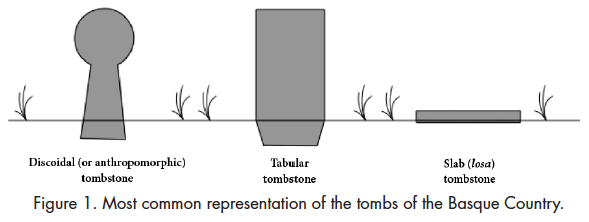 Display large image of Figure 1
Display large image of Figure 1
11 Ancient funerary rites and customs in the Basque Country have also been examined by Barandiaran (1970), Duvert (1976), and William Douglass (1973). It was customary to bury the dead in an eastward-looking position and to mark the grave at the head, generally with a discoidal stela that could include the name of the deceased, the date of death, and Christian signs such as the monogram of Christ or a cross. The older stones include images that refer to the office held by the deceased person, as well as various solar, astral, and geometric symbols. This funerary decor has given rise to a modern Basque iconography that is reproduced on traditional furniture and on the facades of houses and farmsteads since the sixteenth century or earlier. The characteristic shape of the letters found on ancient discoidal stelae in the Basque Country is known as the Basque script, although we also find uses of Gothic letters. The inscriptions are generally in Euskera, or variously in Latin, French, or Spanish.
12 Four of the five funerary markers in Placentia have a tabular form, in contrast to the many discoidal stones that can still be seen in many eastern Basque villages of Zuberoa (Soule), Benafarroa (Lower Navarre), Nafarroa (Navarre), and Lapurdi (Labourd). Discoidal gravestones are less frequent in the western provinces of Gipuzkoa, Bizkaia, and Araba. Four of the Placentia inscriptions are in Euskera while the remaining one, on a different type of stone, is written in French. This last stone is a horizontal slab or “table stone.”
13 Over the years, different translations have been proposed for the texts from Placentia, which are written in Euskera dialects of Lapurdi and Benafarroa. Beginning in the late nineteenth century, several attempts were made to translate the texts, especially that of the first marker (Tombstone 1), by Howley (1888, 1902, 1909), Edward Dodgson (1909), Colas (1923), Enrique de Gandía (1942), and Anes Arrinda (1977). The first attempt by Howley was limited by his ignorance of Euskera. The deterioration of the stones, which has left some texts truncated, has also hampered the reading of the texts.
14 Of the four tombstones that have been previously discussed in print, three have Euskera inscriptions in the characteristic Basque script, along with religious and astral symbols that are also typical of Basque tombstones. The fourth is a distinctive, horizontally-laid slab that is longer and thinner than the three other markers, and its text is in French. To this corpus we may add a fifth grave marker, analyzed here for the first time. We have preserved Howley’s numerical order to identify the stones from 1 to 4, and number 5 is the newly identified example. However, we will treat Tombstone 4 last, because its distinctive material and French inscription require a different analytical approach. The French text is incised, and not carved in relief as on the Basque-language stones. The deceased person is known from other sources, and we will provide some additional information on his career.
15 These seventeenth-century tombstones reveal Basque personal names at a specific time in their long history. In the Middle Ages, personal names were quite different from those we see on the Placentia markers. Medieval names like Amaia, Azeari, Andere, Gartxot, Santxo, and Saubat disappeared with extensive Christianization, when local religious authorities imposed Latin-derived names and spellings based on Spanish usage in the southern part of the Basque Country (Hegoalde) and on French usage in the north (Iparralde). In the south, this practice continued until 1977, when names in the different official languages of Spain, including Euskera, were allowed. As well, in 1999 it became legal to write last names in modern Basque spelling and to obtain official personal documents in Euskera. In the north, French law defines Euskera as a cultural heritage, with no legal sway over official use. While parents may give a Basque first name to a child, the spelling of family names still often follows French orthography as written down historically by priests and officials. The history of Basque personal names, however, was not one-directional or uniform. As we shall see, the seventeenth-century names on the Placentia gravestones are in fact Basque adaptations of names also found in French and Spanish.
Tombstone 1
16 We begin with the most complete tombstone, held at the O’Reilly House Museum (Figure 2). This dated, tabular (vertical) marker is handsomely carved, with a frame around the edge and several horizontal lines of text. One of the faces bears the following inscription (original on the left, our translation on the right):
DA HEMEN Here lies
HILA I O Dead
MAI I 1676 1(?) May 1676
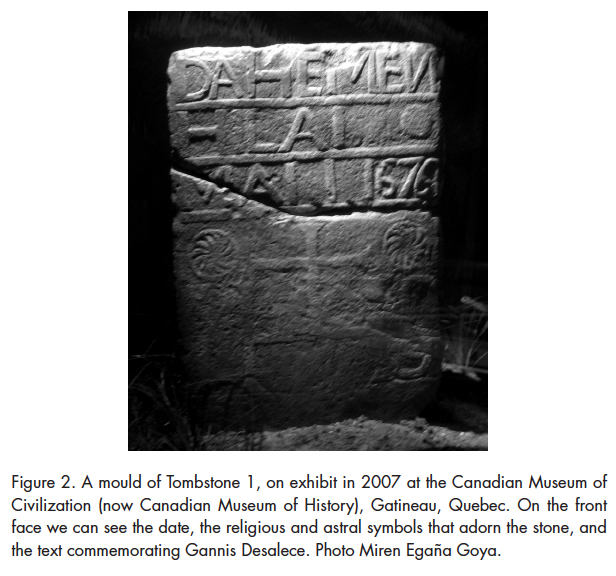 Display large image of Figure 2
Display large image of Figure 2
17 Placed under this text are at least two astral symbols on either side of a cross that is set on a kind of pedestal, which is between the letters /I/ and /S/. These letters, along with the pedestal that functions as an /H/, make up the anagram of Christ, IHS.
18 The front of the stone (Figures 3 and 4) reads:
GANNIS Gannis (Ganix)
DESALE Desalece > de Saleçe (de Saletxe)
CE–ARIA Maria (?)
USANNO Usanno + ene + ko (ko = of, from)
NENECO --------
SEMEA The son
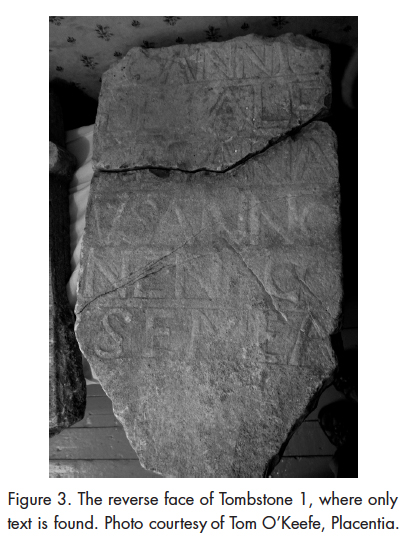 Display large image of Figure 3
Display large image of Figure 3
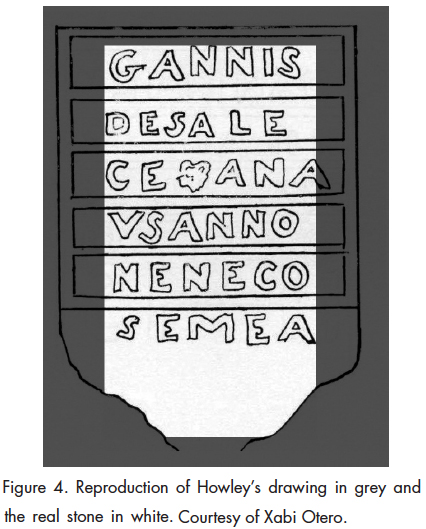 Display large image of Figure 4
Display large image of Figure 4
19 DA HEMEN HILA is a typical linguistic usage of the Iparralde (northern) Basque dialects of the time, meaning “here lies dead.” The use of the “h” was habitual in the spelling of these dialects. As for the syntax, in the Lapurdi and Benafarroa dialects of Euskera, the verb could initiate the sentence without being conjugated in the imperative. In this case, the verb begins with the auxiliary, thus altering the usual word order that would be “hemen hila da” (i.e., adverb, participle, and verb). The phrase is followed by a vertical bar and a space. Howley thought there was some sort of sign between the bar and the following sign, which may be an “o” or a zero, or possibly an astral symbol such as those found lower on the same stone. The month is written in French. It is followed by a vertical bar and the year 1676, unless the bar allows us to read “May 1 1676.”
20 The text on the opposite side of the stone lends itself to further linguistic analysis. GANNIS is a variant of Joanes and would be written “Ganix” in modern Basque orthography. It is a hypocoristic, or diminutive, form of the name Joan (Knörr, 1999: 150). It is common today in Iparralde and often occurs historically in popular songs and literature, and as Joanes in many historical references of Basque sailors who went to Canada.
21 This tombstone has been cited by linguists and philologists as the earliest evidence for the transformation of Joanes into Ganix in historical times (Michelena-Irigaray, 1955: 118). The consonant shift from /j/ to /g/ occurred especially in Lapurdian Euskera, where the former muted fricative consonant /j/ is heard today as a /y/ or even as an occlusive /g/. The same phonetic shift occurred in the homonymic verb joan (“to go”). Ethnolinguistic researchers have recorded its transformation into “gan” in both Lapurdian Euskera and its Nafarroa variant. 4
22 DESALECE, a contraction of “de Salece,” shows the use of “sala” instead of “etxe,” meaning “house” in its toponymic and patronymic sense, that occurs in the eastern dialects of Iparralde, that is, in Benafarroa and Zuberoa (Orpustain, 1981: 134, 138, 139, 181), as well as in Gipuzkoa (Michelena, 1973: 148).
23 Contrary to the Iparralde orthographic tradition, however, the headstone carver did not place an /h/ after the /c/ in “Salece.” We may therefore relate this spelling to a different orthographic tradition, in which /ç/ took the place of the Iparraldean /ch/, and was simplified on this gravestone to /c/. Such a shift from /ç/ to /c/ is common to all languages in which /ç/ is used. In this case, a Spanish orthographic influence may be at work, leading to the hypothesis that Gannis de Salece was from Gipuzkoa.
24 The Gipuzkoan particularity of “Salece” on this gravestone was recognized by the linguist Luis Michelena (1973: 149). Edward Dodgson went on to suggest that the place name Placentia in Newfoundland derived from the Gipuzkoan town of Soraluze– Placencia de las Armas in the Deba valley (Dodgson, 1909). In further support of a Gipuzkoan association, he analyzed the verb “zan” (“was”) that he believed — contrary to our reading — was found on the gravestone. 5
25 –ARIA may be completed, as seen in the photograph, by a ligature of M and A to form the name “Maria.” (In a ligature, two letters are joined to make a single compact character, as is often seen historically for Maria.) In his first study of this inscription, Howley (1888: 144–45) recorded it as –ARIA. For unknown reasons, he later changed his transcription to –ANA (Howley, 1902: 82–83). Our photographs clearly show –ARIA and this is also the spelling retained in the replica of this stone made by the Canadian Museum of History.
26 USANNO NENEKO corresponds to the name of a house or farmstead, to which the appropriate genitive suffix has been added. This composite word appears to be based on the noun “uso” (dove, pigeon), followed by the diminutive “-nno” to create “usaño,” meaning a small dove or dovelet. The word is completed by the suffix “–enea” (house) and finally the declension suffix “–ko” (of, from). Based on this reconstruction, it appears that the name of the house or farmstead was Usannonene, i.e., Usannone + -enea, to which the locative suffix –ko was added, after dropping the final “a,” to mean “of/from Dovelet House.” Related forms of this name are found in farmstead names and surnames such as Usategi, Usandizaga, and Usansolo (Michelena, 1973: 161).
27 As often seen in the Basque Country, the length of the name obliged the stone carver to adapt it to the available space, although all the syllables are present.
28 SEMEA, finally, means “ the son” in Euskera.
29 Our translation of the inscription is thus: “Here lies dead, on May 1st 1676, Joanes de Saletxe, the son of Maria of Usanone (Dovelet) House.” As for a possible Iparraldean or Gipuzkoan linguistic affiliation, this is a question of linguistic geography that archaeologists may be able to resolve by determining the origin of the inscription’s stone support.
30 Previous commentators on this gravestone have stumbled on “Usannoneneko” because of its archaic use of the locative genitive case, combined with the possessive genitive, that occurred widely in the Middle Ages but is now unusual in Euskera (Michelena, 1964: 33–34). 6 As well, the word lacks another possessive genitive suffix, -ren, to show the relation between Maria and her son (i.e., Usannonenekoren). It may have been omitted because it made the word too long for the available space on the stone, or because of the cacophony produced by so many suffixes. This results in a flawed construction that reads something like “son Maria of Usasone House.”
Tombstone 2
31 This undated, tabular gravestone is known through the upper fragment of a tabular stela.
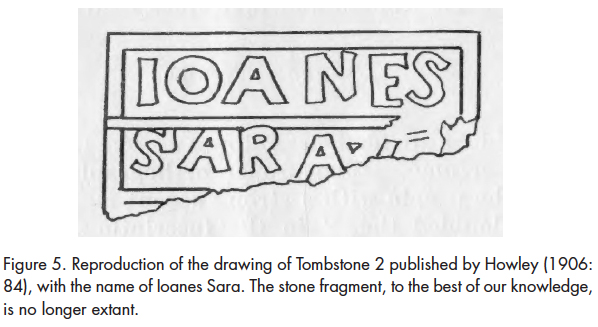 Display large image of Figure 5
Display large image of Figure 5
32 Already broken when Howley recorded it in the nineteenth century, the stone has since been lost. Howley gave its dimensions as 9.5 inches (24.13 cm) in height, 14 inches (35.56 cm) in width, and 3 inches (7.62 cm) in thickness. In his rendering of the inscription, we read:
33 “Ioanes” is a typical historical form of today’s personal name Jon (Michelena, 1961: 173), while “Sara” is the name of a town in Lapurdi, as well as a family name. The text is laid out between double horizontal lines, and the two names are on separate lines. On the opposite side of the stone, we see a cross and the top of an S, which may have been part of the anagram of Christ. On each side of this motif is a smaller Maltese cross (Figure 6).
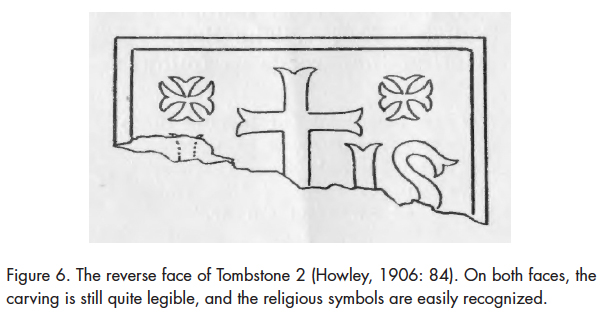 Display large image of Figure 6
Display large image of Figure 6
Tombstone 3
34 Held at O’Reilly House Museum, part of this undated tombstone has disappeared since it was recorded by Howley, in whose drawing we see the upper part of the broken stone, framed by a double line (Figure 7).
 Display large image of Figure 7
Display large image of Figure 7
35 Contrary to the other stones with Basque-language inscriptions, the text is not laid out along construction lines, and the tabular stone has a protrusion in the shape of a half cane on the right side. Based on Howley’s drawing, a similar protrusion existed on the left side but has since disappeared, as shown by the photograph. The measurements are 16 inches (40.64 cm) wide and two feet 6 inches (76.20 cm) long, according to Howley, who already noted the stone’s poor condition on his various visits and predicted that if its deterioration continued, it would disappear entirely. The two fragments retain only part of the original text and name:
36 “Ioannis” corresponds to the present-day personal names Joanes or Jon. As for “Dehiriart,” this is the surname “de Hiriarte” that appears as early as 1246 in Le livre d’or de la Cathédrale de Bayonne, one of the oldest repertories of Basque personal names (Orpustain, 2010: 24, 25, 28, 31). The inscription is carved in a vivid Basque script, even with some letters in reverse, a common feature of tombstones in the Basque Country (Colas, 1923: 32). In this example, the carver has divided the names according to the space available on the stone support. The name “Ioannis” has been divided in the middle of the double consonant, according to French-language syllabic formation. Such a division, placing a consonant on each side of a vowel, is inconsistent with Euskera syllables. Often linguistically problematic in this way, Basque funerary stones show that the carvers could divide words simply to fit the available space.
Tombstone 5
37 Howley did not describe this undated, tabular stone, which is also held at O’Reilly House Museum and analyzed here for the first time (Figures 8 and 9).
 Display large image of Figure 8
Display large image of Figure 8
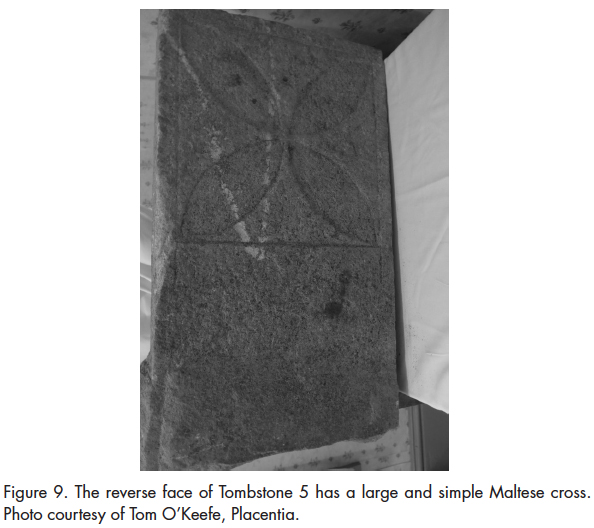 Display large image of Figure 9
Display large image of Figure 9
38 We have not been able to ascertain when or how this stone came to light. It is quite complete and well preserved, and the text is legible except in the upper left of one face, which appears to have been damaged by vandals. As on the other stones, the inscription is in Euskera, and the text is framed and carved between lines. Here as well, we notice a problematic inter-syllabic division, with the consonant on one line and the associated vowel on the following line. Based on the photograph, the stone’s dimensions are similar to those of Tombstone 1.
39 On one side, we read the inscription:
40 The personal name “Piarres” (sometimes found as “Pierres”) is borrowed from the French and is common in the Euskera dialects of Iparralde in France. As for the surname “Detchegaray,” it integrates the French or Spanish genitive “de” (of, from) that Basques use, by customary right, to designate their place, house, or farmstead of origin. Basques in Iparralde often follow the French style and combine the “de” with the surname, as seen in Dehiriart, Desalece, and Detchegaray. 7 The latter surname also appears in Le livre d’or de la Cathédrale de Bayonne of 1246 (Orpustain, 2010: 17, 31, 136, 160). On the opposite side of the stone, in the space normally occupied by the inscription, we find a carved Maltese cross.
Tombstone 4
41 We will now examine the somewhat exceptional tombstone of Jouanes Suigaraichipi, dit Croisic, which appears as a dated, horizontally-laid slab with a lengthy French inscription. Howley, following the view of Légasse, identified the name as“pure Basque” (Howley, 1902: 87). The deceased person was well known in his day and elements of his biography survive to our time. The stone’s dimensions, as recorded by Howley, are 2 feet 5 inches (73.66 cm) in height and 16 inches (40.64 cm) in width (Figure 10).
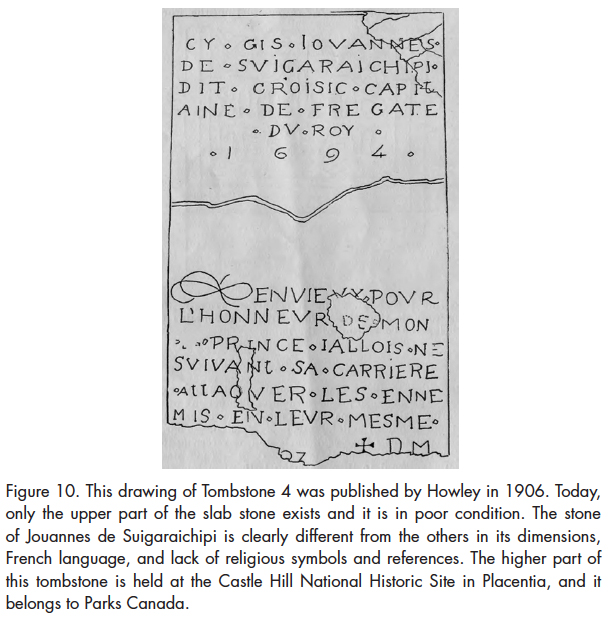 Display large image of Figure 10
Display large image of Figure 10
42 Contrary to the other tombstones, this is a horizontal slab, measuring only 3 inches (7.6 cm) in thickness. When he first saw the stone (in 1872), Howley described the material as being similar to slate and stated that it was very fragile. It was in two pieces, and Howley thought that the two fragments were the separated faces of a vertical stone with separate inscriptions on the front and the back “that had recently become split or cleft in twain” (Howley, 1902: 85–87). However, Légasse told him in 1900 that the two texts in fact followed each other on the same face. Soon after (in 1902), Howley returned to Placentia, re-examined the fragments, and understood that they were end-to-end portions of a horizontal “table tomb” measuring “at least eight feet long” (2.44 metres), which had broken in the middle of its length (Howley, 1902: 91–92). The fragment with the first part of the text is preserved at Castle Hill National Historic Site in Placentia and is in poor condition, while the fragment with the second part of the text has disappeared.
43 Suigaraichipi’s tombstone is longer and thinner than the other tombstones, and its long text is written in French and not in Euskera. Unlike the stones with texts in Euskera, the letters are not carved in relief Basque script, but rather incised in lean capitals. The secular character of the text’s contents has to be noted, too. In addition to the name of the deceased person, we read that he was a frigate captain in the service of the King of France. As well, unlike the other tombstones that have symbolic engravings such as a cross, the anagram of Christ, Maltese crosses, and swirling suns that hark to the primitive religion of the Basques, the religious signs on this stone are modest in size and position. There is only a tiny Maltese cross on the lower part of the stone, at the end of the text, followed by the initials DM, whose meaning may be the conventional Latin funerary expression Deis Manibus. The deceased person’s identity is stated in three different ways, as his proper name (Jouannes de Suigaraichipi), his nickname (Croisic), and his military title (Capitaine de Frégate du Roy).
44 Thus we read (our translation is on the right):
Howley commented on the word “Envieux,” whose meaning he understood after several false readings:
This is the interpretation Howley ultimately provided:
45 Jouannes de Suigaraichipi dit Croisic was a celebrated sailor in his time, according to Anes Arrinda (Arrinda, 1977: 223), and his biography may be added to those of other well-known seventeenth-century Placentia personalities (Barkham, 1994; Landry, 2008; Crompton, 2017). Édouard Ducéré informs us that Suigaraichipi was born in Bayonne, rue de la Galuperie, 8 and that he was known as “Coursic,” which meant a petty corsair in local familiar language (Ducéré, 1908: 76–78, 222–29, 302–12). Little is known of his youth, other than that he sailed in merchant ships and made several voyages to the “Isles of America.” In 1691, he outfitted a frigate named Légère and was authorized as a corsair by the King of France to capture any enemy ship, particularly from Spain and Holland. The Duke of Gramont, governor of Bayonne, supplied half the Légère’s outfit, and in six years Captain Croisic captured more than a hundred merchant ships. The corsair targeted Dutch ships in the Basque ports of Spain, in Getaria, Donostia (San Sebastián), and Pasaia (Pasajes), where he attacked a Dutch ship carrying ropes, sails, masts, gunpowder, and munitions destined to outfit a new flagship of the Spanish navy that was being built in Pasaia.
46 On one occasion, Croisic was outgunned by an English frigate, but managed nevertheless to bring it into Bayonne. The feat earned him the recognition of “King’s Frigate Captain.” In 1693, the French government sent him on a punitive mission to Spitsbergen. He chose the frigate the Aigle, and was accompanied by Captain Harismendy in the frigate Favory; both ships had entirely Basque crews. With them as flagship was the Pelican, under a Saint-Malo captain and a Basque crew, as well as another Malouin ship. The squadron attacked the Dutch and English from Greenland to Spitsbergen. On 20 July, having reached the sixty-third parallel, Suigaraichipi went in advance of the squadron and captured several Danish ships, which were released, as well as seven Dutch ships.
47 On 1 August, Suigaraichipi rejoined the squadron, bringing with him two Dutch ships and having sunk another. He reported that 50 other Dutch ships were threatened by encroaching ice and would be forced to leave Spitsbergen in a few days. The squadron’s commander allowed the two Basque corsairs to move against the Dutch. On 6 August, Croisic and Harismendy captured seven ships and entered the lagoon where they found 40 Dutch ships waiting for them, moored in a half-moon configuration. In five hours of cannon fire, the Basques arrested 16 ships.
48 On 7 August, the corsairs escorted 11 Dutch ships out of Spits-bergen, having sunk the five others, and reconnoitred with their flag-ship. In total, they had captured 28 ships, of which 11 were forced to sail with them to Donibane Lohizun (Saint-Jean-de-Luz). Along the way, one Dutch ship escaped, but the squadron returned with 10 prizes. In October, Croisic and Harismendy were back at sea, to protect the French fishing fleet returning from Newfoundland and try to capture any English ships in their way. Suigaraichipi’s career, which seemed so bright, came to a sudden end when he was killed in a skirmish with the English in 1694, the same date we read on the gravestone in Placentia. At the time, he was in Newfoundland as captain of the royal frigate the Envieux.
Conclusion
49 In reviewing the inscriptions that were brought to scholarly attention by Howley, we have sought to clarify some linguistic misconceptions, and we have presented a previously unpublished Basque tombstone. These elements broaden our understanding of Basque funerary rituals and expand the knowledge of the Basques’ presence in Canada.
50 On their voyages across the cold North Atlantic, Basque sailors built an enduring heritage, not only giving names to numerous ports, fishing grounds, and landmarks, but also recording their passage in these distant lands. Not all of them safely returned home. Some were reported missing at the sea, while others died working in the whaling stations and fishing ports. As the Basque burials found in Red Bay, Labrador, show, the Basques paid tribute to their dead on Canadian soil, burying their bodies in an ordered and organized manner. The Placentia tombstones shed further light on early European funerary rituals in Canada. Furthermore, their material remains are buttressed by written sources, as early as Domingo de Luça’s will in 1563.
51 The tombstones in Placentia are an interesting example of continuity of Basque funerary customs. Like examples in cemeteries from the same period in the Basque Country, the Placentia stones are erected tabular stelae, each engraved with the name and surname of the deceased. They record other details such as the year of the death, and are decorated with Christian symbols as well as naturalistic signs. The tombstone of Suigaraichipi dit Croisic is different from the others in its French inscription, secular character, and more discrete religious symbols, perhaps reflecting his military career as a corsair in the service of France. Also, it is a slab rather than a tabular stone. We may ask whether this stone had a different origin from typical Basque tombstones. A compositional analysis of the five stones could shed light on their provenance.
52 Already a customary place of interment for Basque fishermen who died in Newfoundland by 1563, the Basque cemetery in Placentia is at least as old as the one in Red Bay. Because of its age and its preserved Basque tombstones, its archaeological value is unique in Canada, where gravestones are uncommon before the nineteenth century (Cornellier, 2005). The two dated tombstones, from 1676 and 1694, belong to the period of the French government in Newfoundland. About the same time, the Basque pilot Piarres Detcheverry wrote his navigation manual, Ixasoco nabigacionecoa (Detcheverry, 1677), and drew two maps of Newfoundland and the Gulf of St. Lawrence (Figure 11), showing this area to be a customary destination of Basque fishermen (Egaña Goya and Loewen, 1995: 247–48). The grave markers thus have a regional heritage significance and their further study and official commemoration can only be encouraged. They are a permanent legacy of the Basque people and their intensive fishery on this distant shore. The Basque government has commemorated other overseas heritage sites, and it would not be misplaced to proceed with a formal commemoration in this case as well, in conjunction with authorities in Canada, the province of Newfoundland and Labrador, and the town of Placentia.
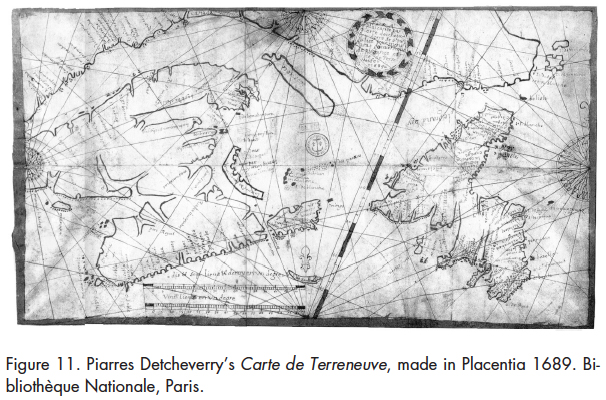 Display large image of Figure 11
Display large image of Figure 11
I wish to thank Lilian Cooper, who alerted me to the stones’ present location. Tom O’Keefe, curator of the O’Reilly House Museum, graciously provided photographs of two of the four tombstones that were previously published, and of the fifth stone that we present here for the first time. Thanks to Aitzpea Leizaola for discussing and reviewing this paper. Thanks finally to Brad Loewen for his English translation and comments.
